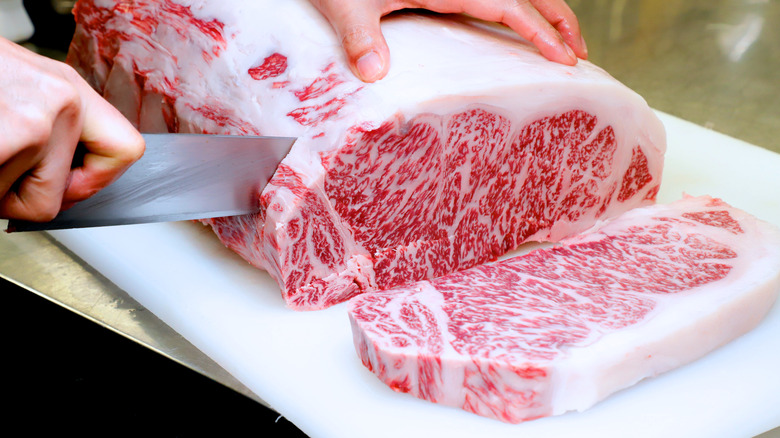Why Kobe Beef Appears White When Raw
Is there anything better than a perfectly cooked, tender, juicy cut of steak? The crust that comes with the perfect sear, with a little bit of pink on the inside and a tender but juicy bite full of flavor ... It's more than enough to get meat lovers' mouths watering. Whether or not you're a beef aficionado, though, chances are good that you've heard of Kobe beef or noticed it (allegedly, says Forbes) on the menu at a fancy establishment. But have you ever seen a raw Kobe steak? It's a rare sight that's a lot lighter in color compared to the bright red you might be used to seeing with the raw steaks at the store.
When you head out to pick up a few steaks for dinner, you're usually looking for that nice, bright red color most likely because it indicates freshness and quality (and just looks tasty). But in the case of Kobe beef, soft pink or even more white is what you'd see, and it's actually a good thing — a side effect of the meat's highly sought-after qualities. So what is all that white stuff, anyway? And what does it have to do with the fact that Kobe beef is so good?
Why you probably haven't seen Kobe beef in person
First, it's important to note that while it may be frustrating, all too often the terms "Kobe" and "Wagyu" are used interchangeably, or simply as a marketing tool on a menu without much real meaning. Wagyu, which to some is shorthand for "really good steak," literally just translates to "Japanese cow," says The Wagyu Shop. There are a few different breeds of cattle that qualify as Wagyu, and they don't even technically have to come from Japan.
Kobe, on the other hand, is a specific brand of Wagyu that has to meet strict requirements to earn its title. True Kobe beef must come from the Tajima breed and be born, fed, and raised in the Hyogo Prefecture of Japan — as well as meet several other conditions including certain weight, texture, and marbling requirements.
The USDA, on the other hand, doesn't have strict or really any standards when it comes to Kobe or "Kobe-style" beef according to Forbes, so the term gets thrown around a lot in the States. Actual graded Kobe beef is pretty hard to find in America, or really anywhere outside Japan: The strict standards result in only a few thousand heads of cattle being certified Kobe each year in a country that only started exporting the meat in 2012, per the Kobe Beef Marketing & Distribution Promotion Association. That means even though you might've seen Kobe on the menu, it probably isn't authentic — unless you're paying a few hundred bucks for it. And it's even more unlikely that you've seen it raw at the grocery store.
Kobe beef's trademark intramuscular fat gives it a white color
If you were to see raw Kobe beef in person, you'd probably be skeptical due to the color, but it's actually a highly-prized trait that arises from some of the same strict protocols that make it so rare to encounter. One of the characteristics of true Kobe beef is its high fat content. According to Fine Wagyu, the meat gets this delicate marbling due to a special diet (even the grain the cows are fed can only come from Hyogo Prefecture) and extended "fattening" period along with the tightly controlled genetics of the Tajima cow.
The smaller veins of fat that give rise to the white color, referred to as marbling because they resemble veins in a slab of marble, are intramuscular fat. A review in The Korean Journal for Food Science of Animal Resources reveals that the fat of this type of cow is special compared to other types of beef: It melts at a lower temperature due to the higher monounsaturated fatty acid content that results from diet and breed. The outcome is a cut of meat that cooks easily on lower heat and remains tender and almost buttery due to the fat melting within the cut.
With the extreme rarity combined with unparalleled flavor and texture, it's no wonder Kobe beef is known as the best in the world. If you ever get a chance to try it, first make sure you're getting the real thing, and then savor the unique piece of meat that starts off white just to melt in your mouth when you taste it.


